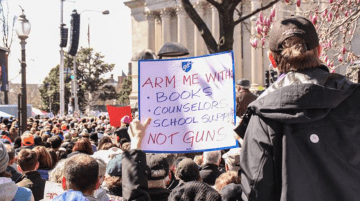Just as schools were becoming safer, Trump ‘safety’ commission likely to halt progress

This post was originally published on December 12, 2018 by The Hill.
In a move likely to make schools significantly less safe, President Trump’s school “safety” commission is about to release a report expected to recommend the cancellation of the Obama administration’s guidance on school discipline that has helped schools find productive alternatives to student suspensions and expulsions.
Significant evidence finds that actions promoted by the guidance — teaching students social and emotional skills, supporting their mental health, and enabling them to take responsibility for their community — improve student behavior, make schools safer, and improve student achievement. The use of harsh exclusionary punishments — the alternative to the positive discipline policies recommended in the guidelines — undermines safety and learning, as student behavior, academic achievement and attainment worsen.
In the Parkland shooting, for example, Nikolas Cruz’ expulsion may have helped drive him to take out his frustration and anger by killing students and staff at his former school. This is not unusual. In school shooting incidents, 95 percent of attackers were current students at the school. Of those, 71 percent said that they felt persecuted, bullied, threatened, attacked or injured by others prior to the shootings.
Schools that create a safe climate by teaching students respect, responsibility and interpersonal skills can change these outcomes. Since the guidance has been in effect, a number of states have adopted its elements and seen declines in suspensions and violent incidents in schools. Indeed, national statistics show that the percentage of public schools recording one or more incidents of violence, theft or other crimes was lower during the period from 2015 to 2016 than in every prior survey year.
The Obama administration guidance also substantially reduced the use of unnecessary suspensions and expulsions, improving school safety and increasing graduation rates.
These harsh punishments are administered at much higher rates to students of color and those with disabilities, and have profound consequences for their entire educational careers. A single suspension can double the odds of a student dropping out. Because students lose instructional time when they’re removed from school, those who are suspended have higher rates of course failure and grade retention, lower graduation rates and are more likely to become involved in the juvenile justice system.
These disparities are not due to differences in behavior. African American students receive longer suspensions for less serious behavior than their white peers. Black students are more often disciplined for harmless behaviors flagged as “insubordination” or “disrespect” that can include such things as being noisy, “loitering” in the hallway, texting, arriving late or missing class, chewing gum or writing on a desk. The young black girl in South Carolina who was body slammed to the floor by a white resource officer, for example, was disciplined for texting on her cellphone and then trying to stay in class when told to leave. A friend who defended her was also suspended for trying to articulate her concern.
There are many examples of early success among states that have pursued these strategies. For example, California prioritized improving school climate and reducing student suspensions as part of its new accountability plan in 2012 and carried them into the school improvement system under the federal Every Student Succeeds Act. It replaced zero-tolerance policies with legislation encouraging restorative practices, which help students understand the consequences of their actions and enables them to make amends. It also developed standards for teachers and administrators fostering competencies in using such practices and teaching social-emotional skills.
Between 2011 and 2016, suspensions declined by 34 percent and expulsions dropped by 40 percent. Meanwhile, California schools became safer: According to federal school safety data, school-based firearms incidents — which were well above the national average from 2009 to 2010 — declined by more than 50 percent, and were far below the national average, in 2015-16. This is also true for rates of school-based fights, bullying incidents, or classroom disruptions. Graduation rates also improved substantially, from 74 percent for the class of 2010 to 83 percent for the class of 2017.
While many states and districts are implementing evidence-based approaches, there is much work yet to do. The rescission of the discipline guidance would remove an important set of resources that supports states and districts in changing harmful practices.
The commission’s expected recommendation will come as the administration seeks to roll back civil rights protections, limiting investigations of patterns of discrimination and proposing cuts to the Office for Civil Rights. Given the extensive research base behind the guidance, and its capacity to help prevent exclusionary and discriminatory discipline practices, rescinding it will exacerbate the inequities in our education system, while rolling back progress on school safety and student attainment. Solid research about children’s safety should trump politics.
Linda Darling-Hammond is Charles E. Ducommun professor of education emeritus at Stanford University and president of the Learning Policy Institute. She currently serves as co-chairwoman of the National Commission on Social, Emotional, and Academic Development and chair of the California Commission on Teacher Credentialing.
Christopher Edley is president of the Opportunity Institute and former dean at the University of California, Berkeley Law School. He was co-chair of the National Commission on Excellence and Equity during the Obama administration and a senior member of the Carter and Clinton administrations.
Photo by Barbara McKenna.
